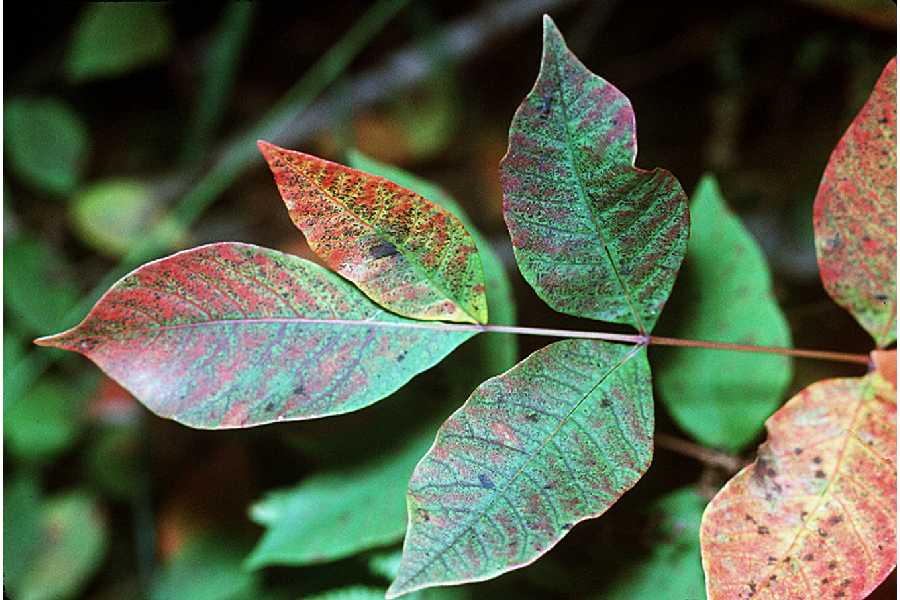- Poison sumac
taxobox
name = Poison sumac
image_caption = Poison sumac leaves
regnum =Plantae
unranked_divisio =Angiosperms
unranked_classis =Eudicots
unranked_ordo =Rosids
ordo =Sapindales
familia =Anacardiaceae
genus = "Toxicodendron "
species = "T. vernix"
binomial = "Toxicodendron vernix"
binomial_authority = Kuntze|Poison sumac ("
Toxicodendron " "vernix" or "Rhus vernix") is a woodyshrub or small tree growing to 7 m (20 ft) tall.cite book
last =Keeler
first =Harriet L.
title =Our Native Trees and How to Identify Them
publisher =Charles Scriber's Sons
date =1900
location =New York
pages =94-96 ] All parts of the plant contain a resin calledurushiol that causes skin and mucous membrane irritation to humans. When burned, inhalation of the smoke causes diarrhea and other internal irritations.Description
The head of the tree is round and narrow and the branches slender and rather pendulous; often it is simply a shrub. Small branches and young stems pithy. Has acrid, milky, poisonous juice which turns black on exposure.
The compound leaves are pinnate, 25-50 cm long, with 7 - 13
leaflet s; the leaflets are 4-10 cm long and sometimes mistaken for individual leaves. The veins from which the leaflets grow are always red.The
fruit is a small white or greyberry , produced inpanicle s 10-20 cm long; this distinguishes it from othersumac s which have red berries. Differs from other sumacs in having shorter leaves, leaflets fewer, margins are entire. It is found in wet soils, whereas the others like it dry.* Bark: Smooth, light or dark gray, slightly striate. Branchlets are smooth, reddish brown, covered with small, orange colored, lenticular spots; later they become orange brown and finally light gray.
* Wood: Light yellow with brown lines; light, soft, coarse-grained, brittle. Sp. gr., 0.4382; weight of cu. ft., 27.31 lbs.
* Winter buds: Terminal bud is much larger than the axillary buds, all are acute, dark purple.
* Leaves: Alternate, pinnately compound, seven to fourteen inches long, borne on slender reddish petioles. Leaflets seven to thirteen, obovate, or oblong, three to four inches long, slightly unequal or contracted at the base, entire, acute or rounded at the apex, short petiolate except the terminal one which sometimes has a stalk an inch in length. They come out of the bud orange colored and downy, when full grown are smooth, dark green and shining above, pale beneath; midrib and primary veins prominent. IN autumn they turn scarlet and orange.
* Flowers: June, July. Dioecious; yellow green, borne in long, narrow, axillary panicles crowded near the ends of the branches. Bracts and bractlets are acute, downy, and fall as the flowers open.
* Calyx: Five-lobed, lobes acute, short.
* Corolla: Petals five, acute, yellow green.
* Stamens: Five, with long slender filaments and large orange colored anthers. In the fertile flowers short and rudimentary.
* Pistil: Ovary ovoid-globose, one-celled, surmounted by three thick spreading styles; ovule solitary.
* Fruit: Drupaceous, globular, white, borne in long graceful racemes, often tipped with the dark remnants of the styles. Ripens in September and frequently hangs on the tree the entire winter. Cotyledons flat, leaf-like.Distribution
Poison sumac grows exclusively in very wet or flooded soils, usually in
swamp s and peatbog s, in the easternUnited States andCanada .In the U.S., it can grow as far west as
Idaho , where it is found only in the southern part of the state.Toxicity
In the U.S., it is listed under the
Federal Noxious Weed Act of 1974 , as amended (7 U.S.C. 2801 et seq.), as a "noxious weed". Most U.S. states list this plant in similar categories. It is considered one of the "U.S. Invasive Weeds" [http://plants.nrcs.usda.gov/cgi_bin/invasive_all.cgi] . In terms of its potential to causeurushiol-induced contact dermatitis , poison sumac is far more virulent than its relativespoison ivy andpoison oak . According to some botanists, poison sumac ("Toxicodendron vernix") is the most toxic plant species in the United States (Frankel, 1991).The poison shows itself in painful and long continued swellings and eruptions.
Avoidance, treatment, and safety
"For specific information on prevention and treatment of Toxicodendron rashes, see
Urushiol-induced contact dermatitis ."ee also
*
Poison ivy
*Poison oak References and external links
* [http://plants.usda.gov/java/profile?symbol=TOVE Entry for "TOVE" on PLANTS Database] , USDA.
* [http://www.dnr.wi.gov/org/land/Forestry/treeid/TreePgs/toxicodendronvernix.htm Wisconsin page for poison sumac] .
* [http://www.henriettesherbal.com/faqs/medi-2-7-poison-ivy.html Poison ivy / oak / sumac] in "The Medicinal Herb FAQ".
* [http://www.poison-sumac.org The Poison Sumac Page] Photos and facts about poison sumac.
* [http://waynesword.palomar.edu/ww0802.htm Poison Oak] at "Wayne's Word"
* [http://www.pesgce.com/toxicodendrondermatitis/derm.asp Toxicodendron Dermatitis: Identification, Immunologic Mechanisms, Diagnosis, and Treatment]
* Frankel, Edward, Ph.D. 1991. Poison Ivy, Poison Oak, Poison Sumac and Their Relatives; Pistachios, Mangoes and Cashews. The Boxwood Press. Pacific Grove, CA. (call #QK 495.A498 F73 1991). 98pages.
Wikimedia Foundation. 2010.
